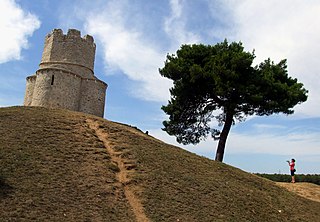
Dalmatia is one of the four historical regions of Croatia, alongside Croatia proper, Slavonia, and Istria and is located on the east shore of the Adriatic Sea in Croatia.

Zadar ( ZAH-dar, Croatian: [zâdar]; historically known as Zara, is the oldest continuously inhabited city in Croatia. It is situated on the Adriatic Sea, at the northwestern part of Ravni Kotari region. Zadar serves as the seat of Zadar County and of the wider northern Dalmatian region. The city proper covers 25 km2 with a population of 75,082 in 2011, making it the second-largest city of the region of Dalmatia and the fifth-largest city in the country.

Split-Dalmatia County is a central-southern Dalmatian county in Croatia. The administrative center is Split. The population of the county is 455,242 (2011). The land area is 14.106,40 km2. Split-Dalmatia County is Croatia's most rapidly urbanising and developing region, as economic opportunities and living standards are among the highest alongside capital Zagreb and Istria County.

Salona was an ancient city and the capital of the Roman province of Dalmatia. Salona is located in the modern town of Solin, next to Split, in Croatia.

Nin is a town in the Zadar County of Croatia, population 1,132, total municipality population 2,744 (2011).
The Delmatae, alternatively Dalmatae, during the Roman period, were a group of Illyrian tribes in Dalmatia, contemporary southern Croatia and western Bosnia and Herzegovina. The region of Dalmatia takes its name from the tribe.

Liburnia in ancient geography was the land of the Liburnians, a region along the northeastern Adriatic coast in Europe, in modern Croatia, whose borders shifted according to the extent of the Liburnian dominance at a given time between 11th and 1st century BC. Domination of the Liburnian thalassocracy in the Adriatic Sea was confirmed by several Antique writers, but the archeologists have defined a region of their material culture more precisely in northern Dalmatia, eastern Istria, and Kvarner.

The Liburnians or Liburni were an ancient tribe inhabiting the district called Liburnia, a coastal region of the northeastern Adriatic between the rivers Arsia (Raša) and Titius (Krka) in what is now Croatia. According to Strabo's Geographica, they populated Kerkyra until shortly after the Corinthians settled the island, c. 730 BC.

Ljudevit or Liudewit, often also Ljudevit Posavski, was the Duke of the Slavs in Lower Pannonia from 810 to 823. The capital of his realm was in Sisak. As the ruler of the Pannonian Slavs, he led a resistance to Frankish domination. Having lost the war against Franks, he fled to the south, presumably to Dalmatia, first to an unknown Serb župa, and then to the Croat ruler Ljudemisl, who treacherously killed him.
The "Liburnian language" was a proposed extinct language which would have been spoken by the ancient Liburnians, who occupied Liburnia, a variously defined region in modern southwestern Croatia, in classical times. Classification of the Liburnian language is not clearly established; it is reckoned as an Indo-European language with a significant proportion of the Pre-Indo-European elements from the wider area of the ancient Mediterranean. Due to the paucity of evidence, the very existence of a distinct 'Liburnian language' must be considered hypothetical at this point.

Benkovac is a town and municipality in the Zadar County, Croatia.

Burnum, an archaeological site, was a Roman Legion camp and town. It is located 2.5 km north of Kistanje, in inland Dalmatia, Croatia. The remains include a praetorium, the foundations of several rooms, the amphitheatre and the aqueduct.

Palagruža is a small Croatian archipelago in the middle of the Adriatic Sea. It is uninhabited, except by lighthouse staff and occasional summer tourists.

Petar Šimun "Šime" Budinić Zadranin was a 16th-century Venetian-Croatian Catholic priest and writer from Zadar, Venetian Dalmatia. He was a translator of psalms and catechetical texts, promoter of post-Tridentine Catholicism, and a poet.
Tribanj is a village in the municipality of Starigrad, Zadar County, north Dalmatia. The village consists of seven hamlets: Kozjača, Kruščica, Lisarica, Ljubotić, Običaj, Sveta Marija Magdalena, and Šibuljina. In a geopolitical context, Tribanj was the border of Austrian Kingdom of Dalmatia in the 19th century, and is still viewed as a cultural border between Dalmatia and Croatian Littoral. It is situated on the southern slopes of Velebit mountain, also known as Podgorje.

The Church of St. Nicholas is a late 11th or early 12th century Pre-Romanesque style Roman Catholic church located in the field of Prahulje, one mile from Zadar, between Zaton and Nin in Croatia. It was built on the earthen pyramid mound on top of the Liburnian prehistoric tomb.

Asseria is the name of an ancient hillfort settlement located at Podgrađe, Benkovac around 30 kilometres east of Zadar in Croatia.
The Poletčić family, also known as Polečić or Poličić, was one of the twelve noble tribes of the Kingdom of Croatia, mentioned in the Pacta conventa. They until the 15th century had estates in the region of Lika, around Perušić, and citizen status in the city of Zadar.
Neven Budak is a Croatian historian and professor at the Faculty of Humanities and Social Sciences, University of Zagreb.














